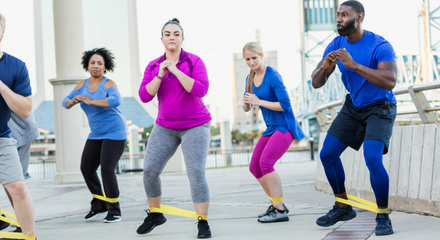If you’re building a new exercise plan, there are so many options out there for physical activity. It can easily be overwhelming to choose what your next workout should be, especially if you aren’t taking a class or following a specific guided program.
However, having a variety of choices actually plays out to your benefit. It can prevent you from getting burned out on just one activity. There are several elements of fitness to consider, and each has different benefits. Cardiovascular exercise, strength-based exercise, endurance exercise, and flexibility all play a pivotal role in your health and fitness. Take your exercise plan one step at a time, knowing a little of each type of activity can go a long way.
Cardiovascular Exercise
Cardiovascular exercise, or aerobic fitness, is any exercise that uses large muscle groups over a long period of time. Typically, when people think of exercise, this is what they think of first.
- Benefits: Lower your risk for heart disease, improve your sleep, manage your weight and decrease feelings of depression.
- Examples: Walking, running, hiking, biking, dancing, swimming.
- How Often: According to the Physical Activity Guidelines for Americans, the recommendation is 150 minutes of activity per week. However, you don’t need to complete this all at once. Exercise can add up quickly during your week if you do it a little at a time. A 20-minute walk at lunch with co-workers, a brisk walk around the soccer field during your child’s practice, or an after-dinner bike ride all add up.
Strength Training
Strength training, or resistance training, involves exercises that are used to build physical strength and to gain and maintain lean muscle mass. As we age, our muscle mass naturally decreases, so strength-training is important to combat or even reverse this decline.
- Benefits: Manage your weight, reduce your risk of injury, and do everyday activities with more ease.
- Examples: Weight-lifting, using resistance bands, body weight exercises.
- How Often: Strength-training takes minimal time. The Department of Health and Human Services recommends at least two sessions per week working all major muscle groups.
Flexibility
Flexibility is the range of motion you have around a joint. Incorporating flexibility exercises into your routine is just as important as cardiovascular activity or strength-training.
- Benefits: Improve your balance and agility, make daily activity easier and reduce your risk for injury. This is even more important with aging.
- Examples: Stretching before or after a workout, yoga, Pilates, tai chi.
- How Often: The American College of Sports Medicine recommends adults engage in flexibility exercises two to three days per week.
Making it All Work
Try not to get overwhelmed! You can make gradual adjustments when changing and adding to your exercise plan. Nothing happens overnight. Start slow and increase the frequency, intensity, duration, etc. over time instead of making major changes all at once.
Take a look at your current level of physical activity to evaluate where you are in your fitness journey. Next, decide where you want to be and determine your goals from there.
- If you are an avid walker and would like to build strength, begin by adding five to 10 minutes of strength exercises after each walk.
- If you are a biker and feel you need to improve your flexibility, try attending a weekly yoga class or reference an online stretching video.
- If you are new to exercise, begin very slowly and increase over time. Start with something as simple as a 10-15 minute walk.
Above all, enjoy the journey of exercise as you begin to improve your overall fitness and reap the health benefits. Exercise is all for YOU — no one else!






